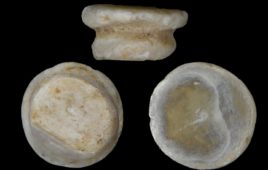
Life reconstruction of the new titanosaurian dinosaur Mansourasaurus shahinae on a coastline in what is now the Western Desert of Egypt approximately 80 million years ago. Credit: Andrew McAfee, Carnegie Museum of Natural History
The discovery of a new species of dinosaur in the Sahara Desert may fill in some unanswered questions on the ancient link between Africa and Europe.
Researchers do not currently have a firm grasp on the final days of dinosaurs in Africa due to a lack of fossils found on the continent from the Late Cretaceous period—between 100-to-66 million years ago.
However, the discovery of Mansourasaurus shahinae—a school-bus length, long-necked plant-eater with bony plates embedded in its skin—in Egypt is bringing scientists one step closer to piecing together the puzzle of dinosaurs’ final days.
“Mansourasaurus shahinae is a key new dinosaur species, and a critical discovery for Egyptian and African paleontology,” Eric Gorscak, Ph.D., a postdoctoral research scientist at The Field Museum and a contributing author on the study, said in a statement. “Africa remains a giant question mark in terms of land-dwelling animals at the end of the Age of Dinosaurs.
“Mansourasaurus helps us address longstanding questions about Africa’s fossil record and paleobiology—what animals were living there, and to what other species were these animals most closely related?”
Late Cretaceous dinosaur fossils are rare in Africa because much of the land where the fossils might be uncovered include lush vegetation, rather than the exposed rock of dinosaur treasure troves.
Throughout much of the Triassic and Jurassic periods, all the continents were joined together as the supercontinent known as Pangaea. However, during the Cretaceous Period the continents began to break apart and shift towards the current configuration.
It remains unclear how well connected Africa was to other Southern Hemisphere landmasses and Europe during this time and to what degree Africa’s animals may have been cut off from their neighbors and evolved on their own separate tracks.
The researchers analyzed features of the new species bones and found that Mansourasaurus was more closely related to dinosaurs from Europe and Asia than it is to species found farther south in Africa or South America.
This reveals that at least some dinosaurs could move between Africa and Europe towards the end of their existence.
“Africa’s last dinosaurs weren’t completely isolated, contrary to what some have proposed in the past,” says Gorscak. “There were still connections to Europe.”
Mansourasaurus belongs to the Titanosauria, a group of sauropods that were common throughout much of the world during the Cretaceous and includes the largest land animals known to science.
The dinosaur represents the most complete dinosaur discovered from the end of the Cretaceous period in Africa. The discovery includes part of the skull, the lower jaw, neck and back vertebrae, ribs, most of the shoulder and forelimb, part of the hind foot and pieces of dermal plates preserved.
“When I first saw pics of the fossils, my jaw hit the floor,” Matt Lamanna, Ph.D., of the Carnegie Museum of Natural History and co-author of the study, said in a statement. “This was the Holy Grail—a well-preserved dinosaur from the end of the Age of Dinosaurs in Africa—that we paleontologists had been searching for for a long, long time.”




